Now four years later, the CBR1000RR gets several revisions but stops short of a full overhaul. New bodywork enhances styling, but it’s the suspension that received most of the R&D work.
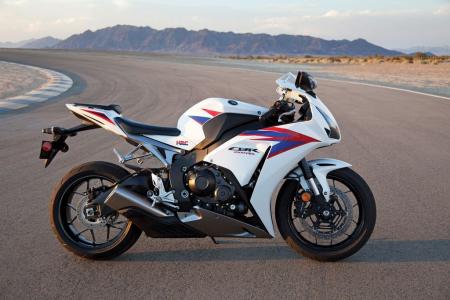 The biggest news from Honda for 2012 is its revamped CBR1000RR. Significant suspension upgrades are the headlining features. The biggest news from Honda for 2012 is its revamped CBR1000RR. Significant suspension upgrades are the headlining features. |
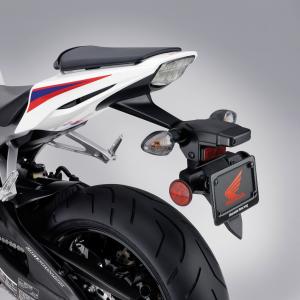 Barely visible here is the new, patented shock from Showa that promises a leap in performance. Showa also supplies its BPF front suspension.
Barely visible here is the new, patented shock from Showa that promises a leap in performance. Showa also supplies its BPF front suspension. New bodywork is the most obvious change to the CBR. It follows the layered fairing concept to improve aerodynamic flow, helping create a large pocket of still air around the rider while also drawing in more air through the cooling system. Also new is an integrated chin spoiler above the front wheel that is claimed to reduce aerodynamic lift at speed.
Also new is the instrumentation. The LCD digital gauge pack now includes a five-level shift indicator, lap timer and gear-position indicator. The digital bar-type linear tachometer offers four selectable modes for style of readout.
The CBR’s midrange-strong motor is basically unchanged, but it did receive new EFI settings that provide response that is more linear and has smoother response at smaller throttle openings.
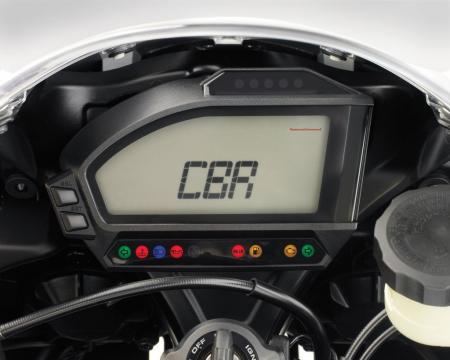 The CBR’s instrumentation is upgraded for 2012, now including a lap timer and a five-level shift indicator, as well as a miles-till-empty function. The CBR’s instrumentation is upgraded for 2012, now including a lap timer and a five-level shift indicator, as well as a miles-till-empty function. |
The CBR’s Combined ABS system receives a minor revision for 2012. This sport-oriented ABS features “a modified front-brake effect better suited to sport riding.” Honda states it reduces front-brake application when the rear brake is actuated, followed by more-progressive front-brake application as brake pedal pressure increases.
The new CBR1000RR is scheduled to hit dealers in December, starting out at $13,800 for the base model. The C-ABS version costs an extra $1000. They’re available in a new Red color to join the existing Black choice, plus a sweet Pearl White/Blue/Red combo that looks HRC-inspired. The C-ABS model is available only in Red. Also, HRC is offering a power-up kit, but it’s intended only for track use.
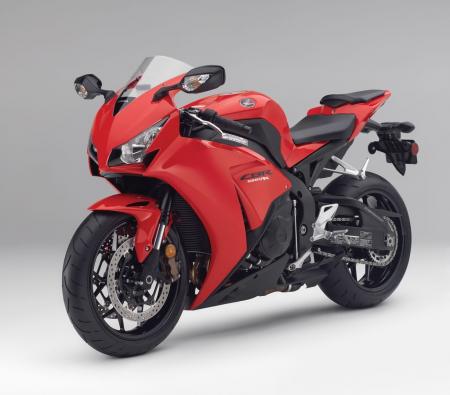 The CBR is also available in a new red color scheme for 2012. The CBR is also available in a new red color scheme for 2012. |
Says Honda: “In the end, the CBR1000RR imparts an uncanny connection between rider and motorcycle thanks to its extraordinary balance, all-around performance and remarkably integrated feel. For 2012, Honda's engineers have further honed and sharpened these characteristics, offering riders the opportunity to step up and open the next chapter to the motorcycle that's become a living legend among sportbikes.”
Honda’s Remaining 2012 Model Updates
Other than the CBR1000RR, the rest of Honda’s 2012 lineup remains essentially unchanged. The only updates are new colors and revised pricing. Still to come is news about some minor revisions to the VFR1200 to be revealed at Milan’s EICMA show in early November.
CBR600RR
Sadly, Honda’s middleweight sportbikes, the CBR600RR and CBR600RR C-ABS, don’t receive any of the goodies in the 2012 CBR1000RR, remaining mechanically unchanged for this year. Available in December of 2011 the 600cc CBRs include standard models in Black and Red for $11,540 and $11,690, respectively, $12,540 for the C-ABS model.
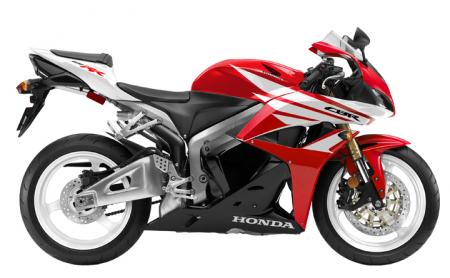 The 2012 CBR600RR is mechanically unchaged for 2012, but it’s now available in this red/white color scheme that’s reminiscent of the original CBR600F2 from 1991. The 2012 CBR600RR is mechanically unchaged for 2012, but it’s now available in this red/white color scheme that’s reminiscent of the original CBR600F2 from 1991. |




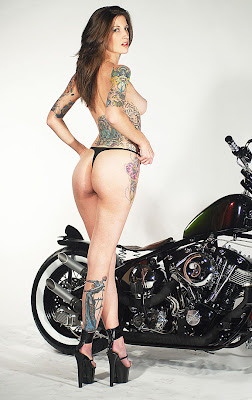







No comments:
Post a Comment